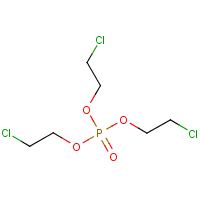Tris(2-chloroethyl) phosphate
Agent Name
Tris(2-chloroethyl) phosphate
CAS Number
115-96-8
Formula
C6-H12-Cl3-O4-P
Major Category
Pesticides

Synonyms
2-Chloroethanol phosphate; Antiblaze 100; Celluflex; Celluflex CEF; Disflamoll TCA; Ethanol, 2-chloro-, phosphate (3:1); Fyrol CEF; Niax 3CF; Niax Flame Retardant 3CF; Phosphoric acid, tris(2-chloroethyl)ester; Tri(2-chloroethyl) phosphate; Tri(2-chloroethyl)phosphate; Tri-beta-chloroethyl phosphate; Trichlorethyl phosphate; Tris(2-chloroethyl) orthophosphate; Tris(2-chloroethyl) phosphate; Tris(2-chloroethyl)phosphate; Tris(beta-chloroethyl) phosphate; Tris-(2-chlorethyl)fosfat [Czech]; Tris-(2-chloroethyl)fosfat [Czech]; [ChemIDplus]
Category
Organophosphate Insecticides
Description
A clear liquid with a slight odor; [HSDB]
Sources/Uses
"Flame retardant in plastics, especially in flexible foams used in automobiles and furniture, and in rigid foams used for building insulation." [IARC]
Comments
Causes slight eye irritation; Skin absorption is minimal; In high dose animal studies, findings include testicular damage, some inhibition of cholinesterase, and central nervous system effects including seizures. CNS effects may be due to cholinesterase inhibition or direct toxicity to brain. [HSDB] “The average of two baseline respective cholinesterase activity determinations three days apart, with no exposures to enzyme inhibiting pesticides for at least 30 days, is recommended for each worker prior to exposure to cholinesterase inhibitors because of large inter-individual differences in published baseline values. To be established at least once a year. Removal from workplace exposures is recommended until the cholinesterase activity returns to within 20% of baseline.” [TLVs and BEIs]
Reference Link #1
Biomedical References
Exposure Assessment
BEI
Acetylcholinesterase activity in red blood cells = 70% of individual's baseline; Butylcholinesterase activity in serum or plasma = 60% of individual's baseline; Sample at end of shift; [TLVs and BEIs]
Vapor Pressure
0.0613 mm Hg
Explanatory Notes
VP from ChemIDplus;
Adverse Effects
IARC Carcinogen
Not classifiable
Other Poison
Organophosphate
Diseases, Processes, and Activities Linked to This Agent
Diseases
Occupational diseases associated with exposure to this agent:
Processes
Industrial Processes with risk of exposure: